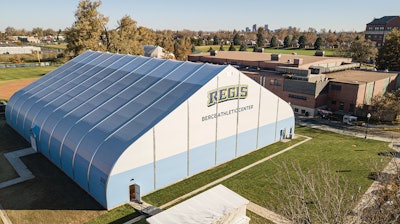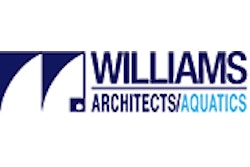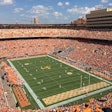
When it comes to developing new athletic, fitness and recreation facilities, traditional construction methods face inherent limitations. The large open spaces and high ceilings needed for playing areas, combined with the common desire for ample natural lighting, can make conventional materials such as steel, concrete, glass and masonry costly.
Increasingly, developers of athletic facilities are turning to the unique capabilities of fabric structures. These versatile solutions utilize lightweight, yet incredibly strong and flexible membrane materials, such as architectural fabrics or foil cushions, tensioned over a structural framework. This approach allows for rapid construction of large, open spaces with bright, airy interiors ideal for recreation and competition venues.
“Fabric structures provide a versatile alternative to traditional construction methods, especially for athletic facilities requiring open span areas with great heights,” says Jim Avery, vice president at fabric structure manufacturer Sprung Structures. “They can be deployed rapidly with less cost while delivering truly premium amenities and performance.”

Fieldhouses and gymnasiums
One of the most popular fabric structure uses is for indoor fieldhouses and gymnasiums able to accommodate multiple sports such as basketball, volleyball, tennis and more in a single open layout.
Sprung’s recent project at Regis University is one example of the versatility of tension membrane construction. The new Berce Athletic Center accommodates 12 athletic teams and bathes two full basketball and volleyball courts, as well as auxiliary training areas, in integrated daylighting — a project built in just four months to serve the school’s growing Division II sports programs.
In addition to the fast build times compared to conventional construction methods, the lightweight membrane materials used for fabric fieldhouses provide considerable cost savings over steel framing and brick materials. Those material cost efficiencies only increase over the long-term when accounting for the decades of expected lifespan for modern architectural membranes.

Aquatics centers and natatoriums
Another area where tensioned membrane construction has made major inroads is with indoor pool facilities and natatoriums. Manufacturing advancements in thermally insulated tensile systems have allowed fabric structures to provide a fully conditioned, energy-efficient environment for year-round aquatics programming.
Companies that design and manufacture fabric structures can realize fully customized and integrated indoor aquatic centers complete with mechanical systems, lighting rigs, and features such as retractable walls for an open-air experience when desired. The bright, spacious characteristics of fabric natatoriums have made them an increasingly popular choice for parks, schools, clubs and competition venues.
Moreover, fabric natatoriums provide tall peak heights, integrated daylighting, and unique architectural details such as color graphics and translucent wall panels that create an engaging visual experience.
“Clients choose tensioned membrane pools because they get a truly world-class aquatic center with iconic architecture, more natural lighting and clear span areas – all completed much faster and at lower costs than conventional builds,” says Avery.
Sprung’s recently completed Idaho Central Aquatic Center is a good example, as it highlights the versatility and high-end amenities possible with tensile Sprung’s membrane aquatic centers. The 120-foot-wide-by-315-foot-long structure houses two state-of-the-art Myrtha competition pools, over 1,000 spectator seats, and premium details such as a glass curtain wall system.

Sustainable design
In addition to the versatility and economic advantages fabric structures provide for athletic facilities, the construction method also aligns with increasing prioritization of sustainability.
From a materials perspective, the membrane fabrics and lightweight structural framing components employed have considerably lower carbon levels compared to concrete and steel. Less energy-intensive manufacturing processes and recycled content make these materials much more environmentally friendly.
The rapid deployment process for fabric structures also minimizes worksite impacts and disruption. With little to no groundwork or heavy equipment staging required, these structures can be installed within a very compact footprint.
Once erected and occupied, fabric buildings naturally reduce energy demands through integrated daylighting that cuts artificial lighting needs. The translucent membrane materials allow ample sunlight to permeate the interior, reducing lighting costs while providing a brightly lit experience for athletes and spectators.
“Our structures feature integrated translucent daylighting panels in the roof peaks to maximize the use of natural lighting,” Avery says. “For an athletic facility, this makes for a tremendously well-lit and energy-efficient space for training, competitions and other activities.”
Additionally, structures are able to leverage passive solar heating concepts to reduce HVAC energy consumption. By absorbing and retaining the warmth of the sun, facilities can cut heating demands, even during winter months.
“There’s a huge misconception that fabric buildings are not effectively insulated, but that’s just not accurate with modern systems like ours,” Avery states. “Our structures meet most applicable energy codes while providing superior air-tightness for insulation performance far beyond conventional buildings.”
Greener long-term operations
Tensioned membranes are also extremely low maintenance, requiring only light cleaning, treatments or replacements for decades. At the end of their lifespan, typically anywhere from 25 to 30 years, fabric membranes can be recycled, while structural framing components and other materials are also able to be reused or broken down in an efficient manner.
“These structures truly provide cradle-to-cradle sustainability over the full lifecycle,” says Avery. “That’s a tremendously compelling value proposition, as more athletic organizations prioritize green construction and operations.”
As the sports industry continues pushing for greener construction methods, the inherently sustainable characteristics of fabric design and construction could make it an even more attractive solution.
With their ability to efficiently create premium, yet economically viable athletic spaces using innovative materials, fabric structures have become an attractive option for parks, schools, clubs, municipalities and professional sports organizations alike. Their versatility allows developers to explore unique architectural designs that prioritize open layouts, natural lighting and other upscale amenities — all while meeting budget and scheduling targets.
“We want to show people there are high-quality alternatives, now that conventional construction has become so expensive and drawn-out,” says Avery. “Once they go inside a modern membrane athletic facility, they’re always impressed by how much is possible with this technology in terms of performance, aesthetics and cost-efficiency.”
As the costs of conventional construction materials and labor show no signs of falling off, the value proposition of fabric structures may catch the eye of athletic facility operators struggling to achieve their design goals through traditional methods alone.





































